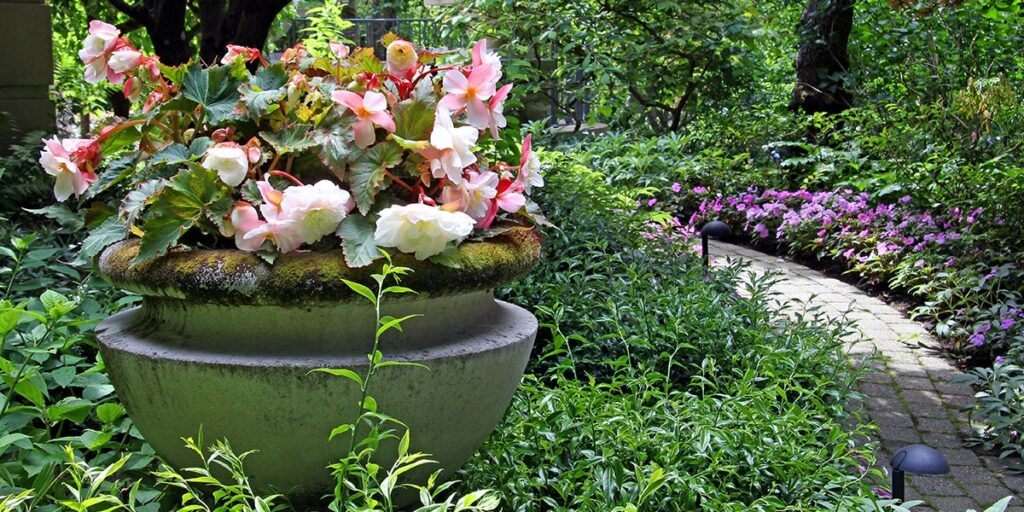
By Angelo Randaci, Earth’s Ally Horticulturist
Angelo’s passion for plants has led him to explore many areas of horticulture including research, grounds management, technical training, design and nursery management.
Shade Loving Plants
Shade gardens are some of the most soothing comfortable places to spend a lazy afternoon. They are a respite from the summer heat, a quiet place for woodland creatures and a wonderful spot for meditation. But not all shade is alike. Shade comes in many shapes and styles. There is dense shade, full shade, light shade, and partial shade. There is shade created by shadows and shade created by a thick canopy. Shade can be gloomy and dim or bright and enlivening. Understanding shade-producing factors will help with plant selection and over-all shade garden design. A shady location is typically considered any area that receives less than 6 hours of full, direct sunlight. There are several variables to consider when defining a shade area and shade loving plants as mentioned above. First observe what is creating the shade: What are the sun-blocking structures; a building, a tree, many trees, tall shrubbery, fencing? A garden next to a shade-creating building is different than a location underneath a tree.
Next figure out how much shade is available. Does the time of the year or time of day change the shaded area? What is the size and shape of the trees or shrubs creating the shade? Your latitude is another variable: how far north or south is your location? The distance from the equator defines the intensity of the sun at various times of year.
While many plants are tolerant of shade, most plants that grow in shade benefit from bright light. An hour or two of early morning sun and a splash of late afternoon setting sun can brush over most plants without harm.
Shade gardens, like all gardens, start with a nutrient rich well-drained soil. This is key to being successful with any garden. All the plants mentioned here will benefit from amended soil.
6 Types of Garden Shade
- Dense Shade: The most challenging type of shade to successfully grow healthy plants is dense shade. Dense shady areas are defined as spaces that receive no direct sunlight and very little bright light.
- Deep Shade: Deep shade is created from overhangs, dense canopy trees, tall shrubs, evergreens, buildings or walls. If at all possible, these areas should be amended in order to create an environment where plants can thrive. It may mean selectively pruning trees or shrubs to open up the canopy and allow more light to filter in. If your shade is caused by a dense canopy of trees, planting challenges exist below the ground as well. Tree roots, especially from shallow rooted trees, such as maple trees, compete with your plants for moisture and nutrients. Digging under trees is difficult and adding soil to make planting easier is only a temporary solution because tree roots will eventually penetrate the top layer of soil. Instead of planting these difficult areas, consider installing garden art or carve out a seating area instead of plantings. Plant along the outside edges of the trees where there is ample light and less root competition. Add containerized plants to your composition and move them to brighter light when they become stressed. If your dense shade comes from tall buildings, walls or fences, amending the soil or raising beds will allow you to grow plants that normally would not grow in a full shade garden.
- Tree Shade: The degree of shade varies among different species of trees. For instance, the area under a linden tree would be considered dense shade whereas the area under a honey locust would be dappled shade (see below for description of dappled shade).
- Full Shade: This type of shade is less demanding for plant selection than dense shade. Full shade plants need areas that are shady all day with very little if any direct sunlight but may receive some reflected light and more or less light during different seasons. You can brighten these spaces for plants that grow in full shade by providing reflected light. Use Light colored fences, pathways or other light-colored structures to bring light to these shady spaces.
- Light Shade or Dappled Shade: Light shade or dappled shade is defined as an area where there is shade, but some light is available at the same time. Many plants will grow in this type of light. Plants for light shade areas may include a tree that provides a dappled shade underneath its canopy is the Thornless Honey Locust. Its small leaves and open structure allow light to penetrate the canopy to provide a pleasant combination of light and shade. Woodland plants such as ferns will thrive in dappled shade with moist soil.
- Part Shade: These areas receive direct sunlight, but only during predictable parts of the day. There are two categories of part shade, morning shade, where areas are shaded in the early morning hours but receive sun in the afternoon and afternoon shade, in which there is sun in the morning but shade in the afternoon. Many shade plants will thrive with morning sun and many sun loving plants with thrive with afternoon sun.
Plant Labels
Understanding plant labels is sometimes confusing where sun vs. shade tolerance is concerned. A plant label might read “plant in shade” or “plant in part shade” but what part of the day? This is important when placing plants. If your garden area receives afternoon sun, you are basically looking at sun plants. If the area receives only morning sun then most shade plants will grow in that area. So, if the plant tag recommends part shade or part sun conditions you can follow these guidelines: If a label reads part sun to sun, this means it will grow and bloom with a minimum of four hours of direct sunlight. Although these plants will tolerate some shade, they will achieve the best growth with lots of sun. If a label reads part shade to shade, this indicates the plant prefers to grow in less than six hours of direct sunlight per day and grows best with morning sun. If a label reads sun or shade this plant will grow in any amount of sunlight.
Shade Garden Design Ideas
Assess your type of shade, dense shade, full shade, light or dappled shade, or part shade. In need of shade garden ideas? Make any changes such as thinning a tree canopy to allow more light penetration or adding trees to provide more shade. Add heavy pieces of garden art while easy access to the area before putting in plant beds.
Consider how to get water to the garden. Providing adequate water is often a challenge in shade because shady areas tend to be dry. Even during a heavy rain, a good amount of the water is deflected from the canopy of trees or overhangs around buildings.
Create curved garden beds. Gentle curves add a calming effect. The gentle sweep of a curve helps soften harsh lines and encourage movement through the garden. Use a hose to outline the curves to see where you want them before defining the beds.

After the shape and location of the beds is decided, put in your garden paths. Your garden path will create a sense of purpose and destination. You can use mulch, gravel, or visit your local stone yard to see the many types of stones that are available. Keep in mind that while mulch is an inexpensive way to go, it will need refreshing every year or two. Irregular shaped stones will add to a natural look whereas square or round ones will look more formal.
This is a golden opportunity to beautify a tired lawn area struggling from the shaded conditions. Keep a small area of turf but surround it with your shade garden plants. If too much shade for turf, plant shade-loving groundcovers instead and create a pathway through them.

Add garden art. Garden art creates a focal point and attracts attention to the garden. Adding art to the garden will create contrast in texture and shape from the plants. Use art to insert a splash of color to the garden. A colorful container will increase color beyond the shades of green from your plants. If you live in colder climates garden art will create winter interest while your plants are sleeping.
The backbone of your shade garden will come from foliage. Combine different leaf colors, shapes and sizes to create a colorful mosaic of texture and form. Use plants with different textures by combining large bold-leaved plants such as hostas with finer textures such as gold-colored sedges, liriope and ferns.
Go with lots of light colors to brighten up the darker shaded areas. Use variegated selections of plants to add extra color. Shade gardens are more about leaf color than flower color.
Plant shade-loving shrubs for dramatic color. Hydrangeas are one of the most colorful shrubs for shade. They perform best when receiving morning sun with shade during the hottest part of the day. Many varieties need ample moisture during the hot summer months to thrive. Other shrubs include azaleas, rhododendrons and viburnums, all worthy of a place in your shade garden.
Native plants adapted to woodland situations are maintenance free. Once established, they will flourish in wooded areas. Many of them will grow and bloom before deciduous trees leaf out, then go dormant during summer months. Naturalize bulbs such as daffodils, snowdrops and crocus to grow among your wildflowers for an extra early spring show.

If you have deer visiting your shade areas, choose plants from deer resistant plant lists. Although no plants are completely deer resistant, there are many plants deer will avoid.
Many vegetables will grow in partial shade. Leafy vegetables are the most shade tolerant. Choose colorful varieties such as red leaf lettuce to plant in your shade vegetable garden to provide color as well as fresh additions to your meals.
Augment your garden with shade loving annuals such as impatiens, begonias and fuchsias. They will grow best in areas with 4-6 hours of shade with morning sun, east facing locations or dappled shade. Include caladiums to add vivid color and diversity of foliage.
We’d love to hear how Earth’s Ally is helping you grow shade loving plants. Share your experience and stay connected with the #EarthsAlly community on Facebook, Instagram and Twitter for access to our latest blog posts, giveaways and exclusive promotions.
